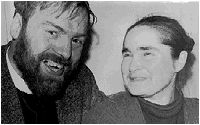|
From Mr To Mrs
As the milestone of 60 approaches and
retirement beckons, it is not unusual to take a nostalgic look back at life. The
things we’re proud of, the regrets, the missed opportunities and the things we
may have done differently with hindsight.

In the case of the Reverend William Parry, that reflection effected a striking
and quite awesome transition. At the age of 59, deciding he could no longer
ignore his true identity, Rev Parry stepped out of his male attire for the last
time and, from that day on, chose to be known ‘Dian’.
An undoubtedly glamorous woman, dressed in a stylish mint-green trouser suit and
chiffon scarf, Dian looks every inch the well-groomed mature female.
“I was a size 18, you know – now I’m down to a 14.” She’s clearly
proud of her ability to win the inch war – a war many women (or RGs - real
girls as Dian calls them) battle with most of their lives. “Mind you, I
haven’t lost any of my D cup.” She proudly displays an enviable bust line.
As a married man of nearly forty years with seven grandchildren, Reverend Parry
feared a negative reaction from his church and family members alike.
“I couldn’t live as a man any longer,” explains Dian. “… but it’s
such a shame, my two eldest daughters will have nothing to do with me now – I
do miss them - and the grandchildren.”
Born in 1939 in Caernarfon, Wales, to a builder father and housewife mother,
Dian knew from an early age that she “was different” from the other boys her
age.
“I was never interested in playing football or rugby with the lads, but then,
I was so shy I couldn’t really associate with the girls either. I felt very
lonely and isolated.”
“My first memory of trying to come to terms with my true identity was prompted
when I was very young. I remember being jealous of my younger sister’s ballet
tutu. It was so pretty – I wanted one of my own.”
Growing up in a strict gender-identified era of 1950s Wales, Dian would often
defy playing the expected masculine role by offering to help her mother around
the house. She remembers feeling confused when her mother teased her by saying:
“If you carry on like that, I’ll put ribbons and curls in your hair.”
“What she never knew,” says Dian sadly, “is that I really wanted her to
put ribbons and curls in my hair”.
With her father away in the war, being the eldest son, Dian’s mother looked to
her for support, saying: “You’re the man of the house now.” Little did she
know that it was the last thing that Dian wanted to be.
At the age of 14, feeling confused and alone, Dian felt drawn to the church.
“I joined a local church group after seeing the Billy Graham film. There I
started to feel comfortable with myself for the first time.”
So comfortable, in fact, that Dian made a decision that proved to have a
devastating effect on her life afterwards. “I felt I had to tell somebody, so
I confided in my minister at the time. I tried to explain this feminine side of
me that was becoming an increasing part of my life.”
Sadly, for Dian, the minister was shocked and, by the next day, almost the
entire neighbourhood knew about her sordid ‘confession’. “I think people
just couldn’t understand. So I withdrew – I refused to talk about it. But it
left me scarred - I hadn’t experienced such pain.”
From that day, Dian decided that no one would ever understand and vowed never to
confide in anyone again. At the age of 18 she realised that all the other boys
had girlfriends and, in an attempt to fit in, accepted the role that she
reluctantly felt expected to play.

“I felt so desperate,” she explains, “that I prayed to God and asked Him
to find me a girlfriend who would become my wife”. Shortly after, having
travelled to Birmingham in search of work, Dian met Anita whilst working in an
ice cream factory - the woman who did become her wife. (The two are pictured
above, many years ago.)
“I don’t think there is any woman on this earth who would put up with what
Anita’s had to put up with from me.” Dian describes Anita - whom she now
refers to as her ’partner’ - with enormous affection.
“I thought I loved her, and of course I did at the time… but not in the way
that a man loves a woman. And…” she lowers her voice to a whisper, “sex
was an absolute chore! but I had to look after her in that way – didn’t
I?”
After nearly forty years of marriage, three children and seven grandchildren,
Anita has decided to stand by Dian.
“We’re the best of friends, you know – we go shopping together.”
Prior to her gender change, Dian admits that as a minister for the Independent
Congregational Church, and also the Baptist and Methodist churches, she actively
campaigned against homosexuality.
She talks about how her church teaching and closeted Welsh lifestyle had left
her narrow-minded and ignorant. “I suppose one of the most significant aspects
of accepting my gender dismorphia is that I have become far more accepting of
other sexualities.”
Although no longer a minister, Dian is still a regular churchgoer, and finds
herself now getting angry with some of its traditional teachings. “My pastor
recently announced in church that we should all sign this petition in favour of
retaining Section 28,” she raps a well-manicured fingernail on the desk. “I
find myself disgusted by things like that now.”
|